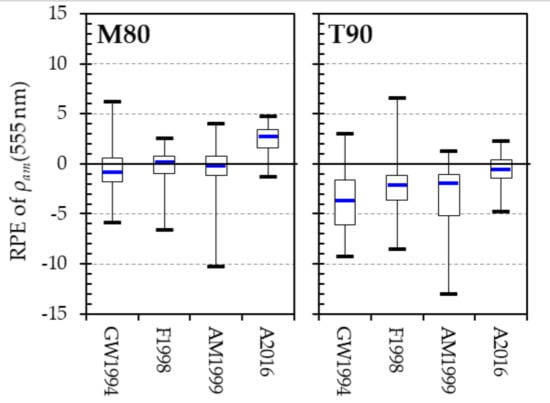Comparison of Aerosol Reflectance Correction Schemes Using Two Near-Infrared Wavelengths for Ocean Color Data Processing
Abstract
1. Introduction
2. The Two-NIR Aerosol Correction Methods Used by the Various Schemes
2.1. GW1994 Scheme
2.2. F1998 Scheme
2.3. AM1999 Scheme
2.4. A2016 Scheme
3. Simulation Dataset for the Evaluation
4. Results and Discussion
5. Note and Summary
Author Contributions
Funding
Acknowledgments
Conflicts of Interest
References
- McClain, C.R.; Feldman, G.C.; Hooker, S.B. An overview of the SeaWiFS project and strategies for producing a climate research quality global ocean bio-optical time series. Deep Sea Res. Part II Top. Stud. Oceanogr. 2004, 51, 5–42. [Google Scholar] [CrossRef]
- Esaias, W.E.; Abbott, M.R.; Barton, I.; Brown, O.B.; Campbell, J.W.; Carder, K.L.; Clark, D.K.; Evans, R.H.; Hoge, F.E.; Gordon, H.R.; et al. An overview of MODIS capabilities for ocean science observations. IEEE Trans. Geosci. Remote Sens. 1998, 36, 1250–1265. [Google Scholar] [CrossRef]
- Kawamura, H.; OCTS Team. OCTS mission overview. J. Oceanogr. 1998, 54, 383–399. [Google Scholar] [CrossRef]
- Rast, M.; Bezy, J.L.; Bruzzi, S. The ESA Medium Resolution Imaging Spectrometer MERIS a review of the instrument and its mission. Int. J. Remote Sens. 1999, 20, 1681–1702. [Google Scholar] [CrossRef]
- Tanaka, K.; Kurihara, S.; Okamura, Y. The sensor characterization of global imager (GLI) on ADEOS-II satellite. IEICE Trans. Commun. 2005, J88-B, 151–157. [Google Scholar]
- Tanaka, K.; Okamura, Y.; Amano, T.; Hiramatsu, M.; Shiratama, K. Operation concept of the second-generation global imager (SGLI). In Earth Observing Missions and Sensors: Development, Implementation, and Characterization. Int. Soc. Opt. Photonics 2010, 7862, 786209. [Google Scholar]
- Kang, G.; Coste, P.; Youn, H.; Faure, F.; Choi, S. An in-orbit radiometric calibration method of the geostationary ocean color imager. IEEE Trans. Geosci. Remote Sens. 2010, 48, 4322–4328. [Google Scholar] [CrossRef]
- Wang, M.; Liu, X.; Jiang, L.; Son, S.; Sun, J.; Shi, W.; Tan, L.; Naik, P.; Mikelsons, K.; Wang, X.; et al. Evaluation of VIIRS ocean color products. In Ocean Remote Sensing and Monitoring from Space. Int. Soc. Opt. Photonics 2014, 9261, 92610E. [Google Scholar]
- Gordon, H.R.; Wang, M. Retrieval of water-leaving radiance and aerosol optical thickness over the oceans with SeaWiFS: A preliminary algorithm. Appl. Opt. 1994, 33, 443–452. [Google Scholar] [CrossRef] [PubMed]
- Wang, M.; Gordon, H.R. A simple, moderately accurate, atmospheric correction algorithm for SeaWiFS. Remote Sens. Eviron. 1994, 50, 231–239. [Google Scholar] [CrossRef]
- Gordon, H.R.; Brown, J.W.; Evans, R.H. Exact Rayleigh scattering calculations for use with the Nimbus-7 coastal zone color scanner. Appl. Opt. 1988, 27, 862–871. [Google Scholar] [CrossRef] [PubMed]
- Gordon, H.R.; Wang, M. Surface-roughness considerations for atmospheric correction of ocean color sensors. 1: The Rayleigh-scattering component. Appl. Opt. 1992, 31, 4247–4260. [Google Scholar] [CrossRef] [PubMed]
- Wang, M. The Rayleigh lookup tables for the SeaWiFS data processing: Accounting for the effects of ocean surface roughness. Int. J. Remote Sens. 2002, 23, 2693–2702. [Google Scholar] [CrossRef]
- Wang, M. A refinement for the Rayleigh radiance computation with variation of the atmospheric pressure. Int. J. Remote Sens. 2005, 26, 5651–5663. [Google Scholar] [CrossRef]
- Wang, M. Rayleigh radiance computations for satellite remote sensing: Accounting for the effect of sensor spectral response function. Opt. Express 2016, 24, 12414–12429. [Google Scholar] [CrossRef] [PubMed]
- Fukushima, H.; Higurashi, A.; Mitomi, Y.; Nakajima, T.; Noguchi, T.; Tanaka, T.; Toratani, M. Correction of atmospheric effect on ADEOS/OCTS ocean color data: Algorithm description and evaluation of its performance. J. Oceanogr. 1998, 54, 417–430. [Google Scholar] [CrossRef]
- Toratani, M.; Fukushima, H.; Murakami, H.; Tanaka, A. Atmospheric correction scheme for GLI with absorptive aerosol correction. J. Oceanogr. 2007, 63, 525–532. [Google Scholar] [CrossRef]
- Antoine, D.; Morel, A. A multiple scattering algorithm for atmospheric correction of remotely sensed ocean colour (MERIS instrument): Principle and implementation for atmospheres carrying various aerosols including absorbing ones. Int. J. Remote Sens. 1999, 20, 1875–1916. [Google Scholar] [CrossRef]
- Antoine, D. Atmospheric Corrections over Case 1 Waters (CWAC) OLCI Level 2 ATBD 2010, v.2.2. S3-L2-SD-03-C07-LOV-ATBD. Available online: https://earth.esa.int/documents/247904/349589/OLCI_L2_ATBD_Atmospheric_Corrections_case-1_waters.pdf (accessed on 31 October 2016).
- Ahn, J.H.; Park, Y.J.; Kim, W.; Lee, B. Simple aerosol correction technique based on the spectral relationships of the aerosol multiple-scattering reflectances for atmospheric correction over the oceans. Opt. Express 2016, 24, 29659–29669. [Google Scholar] [CrossRef] [PubMed]
- IOCCG. Atmospheric correction for remotely-sensed ocean-colour products. In Reports of International Ocean-Colour Coordinating Group 2010; Wang, M., Ed.; IOCCG: Dartmouth, NS, Canada, 2010. [Google Scholar]
- Vermote, E.F.; Tanré, D.; Deuze, J.L.; Herman, M.; Morcette, J.J. Second simulation of the satellite signal in the solar spectrum, 6S: An overview. IEEE Trans. Geosci. Remote Sens. 1997, 35, 675–686. [Google Scholar] [CrossRef]
- Kotchenova, S.Y.; Vermote, E.F.; Matarrese, R.; Klemm, F.J., Jr. Validation of a vector version of the 6S radiative transfer code for atmospheric correction of satellite data. Part I: Path radiance. Appl. Opt. 2006, 45, 6762–6774. [Google Scholar] [CrossRef] [PubMed]
- Kotchenova, S.Y.; Vermote, E.F. Validation of a vector version of the 6S radiative transfer code for atmospheric correction of satellite data. Part II. Homogeneous Lambertian and anisotropic surfaces. Appl. Opt. 2007, 46, 4455–4464. [Google Scholar] [CrossRef] [PubMed]
- Franz, B. rhoa_to_rhoas()—MS Aerosol Reflectance to SS Aerosol Reflectance, aerosol.c in SeaDAS Code 2004. Available online: http://seadas.gsfc.nasa.gov (accessed on 31 October 2016).
- Wang, M. Correction of artifacts in the SeaWiFS atmospheric correction: Removing discontinuity in the derived products. Remote Sens. Environ. 2003, 84, 603–611. [Google Scholar] [CrossRef]
- Ahmad, Z.; Franz, B. Atmospheric correction using multiple-scattering epsilon values. In Proceedings of the Ocean Optics XXII, Portland, MA, USA, 26–31 October 2014. [Google Scholar]
- Antoine, D.; Morel, A. Relative importance of multiple scattering by air molecules and aerosols in forming the atmospheric path radiance in the visible and near-infrared parts of the spectrum. Appl. Opt. 1998, 37, 2245–2259. [Google Scholar] [CrossRef] [PubMed]
- Morel, A.; Maritorena, S. Bio-optical properties of oceanic waters: A reappraisal. J. Geophys. Res. 2001, 106, 7163–7180. [Google Scholar] [CrossRef]
- Siegel, D.A.; Wang, M.; Maritorena, S.; Robinson, W. Atmospheric correction of satellite ocean color imagery: The black pixel assumption. Appl. Opt. 2000, 39, 3582–3591. [Google Scholar] [CrossRef] [PubMed]
- Shettle, E.P.; Fenn, R.W. Models for the Aerosols of the Lower Atmosphere and the Effects of Humidity Variations on Their Optical Properties. Air Force Geophysics Lab Hanscom Afb Ma. 1979, No. AFGL-TR-79-0214. Available online: http://www.dtic.mil/docs/citations/ADA085951 (accessed on 17 September 2018).
- SeaWiFS Reprocessing #4 (2002)—Case 7: Improved Cloud Flagging Method. Available online: https://oceancolor.gsfc.nasa.gov/reprocessing/r2002/seawifs/ (accessed on 10 June 2018).
- O’Reilly, J.E.; Maritorena, S.; Mitchell, B.G.; Siegel, D.A.; Carder, K.L.; Garver, S.A.; Kahru, M.; McClain, C. Ocean color chlorophyll algorithms for SeaWiFS. J. Geophys. Res. 1998, 103, 24937–24953. [Google Scholar] [CrossRef]
- Wang, M. Extrapolation of the aerosol reflectance from the near-infrared to the visible: The single-scattering epsilon vs multiple-scattering epsilon method. Int. J. Remote Sens. 2004, 25, 3637–3650. [Google Scholar] [CrossRef]
- Ahmad, Z.; Franz, B.A.; McClain, C.R.; Kwiatkowska, E.J.; Werdell, J.; Shettle, E.P.; Holben, B.N. New aerosol models for the retrieval of aerosol optical thickness and normalized water-leaving radiance from the SeaWiFS and MODIS sensors over coastal regions and open oceans. Appl. Opt. 2010, 49, 5545–5560. [Google Scholar] [CrossRef] [PubMed]
- Chowdhary, J.; Tsigaridis, K.; Nelson, N. Spaceborne ocean color remote sensing in the UV-A part of the spectrum. In Proceedings of the Ocean Optics XXIV, Dubrovnik, Croatia, 7–12 October 2018. [Google Scholar]
- Gordon, H.R.; Wang, M. Surface-roughness considerations for atmospheric correction of ocean color sensor. 2: Error in the retrieved water-leaving radiance. Appl. Opt. 1992, 31, 4261–4267. [Google Scholar] [CrossRef] [PubMed]
- André, J.M.; Morel, A. Simulated effects of barometric pressure and ozone content upon the estimate of marine phytoplankton from space. J. Geophys. Res. 1989, 94, 1029–1037. [Google Scholar] [CrossRef]
- Tzortziou, M.; Herman, J.R.; Ahmad, Z.; Loughner, C.P.; Abuhassan, N.; Cede, A. Atmospheric NO2 dynamics and impact on ocean color retrievals in urban nearshore regions. J. Geophys. Res. 2014, 119, 3834–3854. [Google Scholar] [CrossRef]
- Tzortziou, M.; Parker, O.; Lamb, B.; Herman, J.; Lamsal, L.; Stauffer, R.; Abuhassan, N. Atmospheric Trace Gas (NO2 and O3) Variability in South Korean Coastal Waters, and Implications for Remote Sensing of Coastal Ocean Color Dynamics. Remote Sens. 2018, 10, 1587. [Google Scholar] [CrossRef]
- Pahlevan, N.; Ahn, J.H. Uncertainty in atmospheric parameters for diurnal remote sensing of coastal oceans. In Proceedings of the Ocean Optics XXIV, Dubrovnik, Croatia, 7–12 October 2018. [Google Scholar]
- Wang, M.; Gordon, H.R. Calibration of ocean color scanners: How much error is acceptable in the near infrared? Remote Sens. Eviron. 2002, 82, 497–504. [Google Scholar] [CrossRef]
- Franz, B.A.; Bailey, S.W.; Werdell, P.J.; Morel, A.; McClain, C.R. Sensor-independent approach to the vicarious calibration of satellite ocean color radiometry. Appl. Opt. 2007, 46, 5068–5082. [Google Scholar] [CrossRef] [PubMed]
- Pahlevan, N.; Roger, J.C.; Ahmad, Z. Revisiting short-wave-infrared (SWIR) bands for atmospheric correction in coastal waters. Opt. Express 2017, 25, 6015–6035. [Google Scholar] [CrossRef] [PubMed]
- Wang, M.; Gordon, H.R. Sensor performance requirements for atmospheric correction of satellite ocean color remote sensing. Opt. Express 2018, 26, 7390–7403. [Google Scholar] [CrossRef] [PubMed]
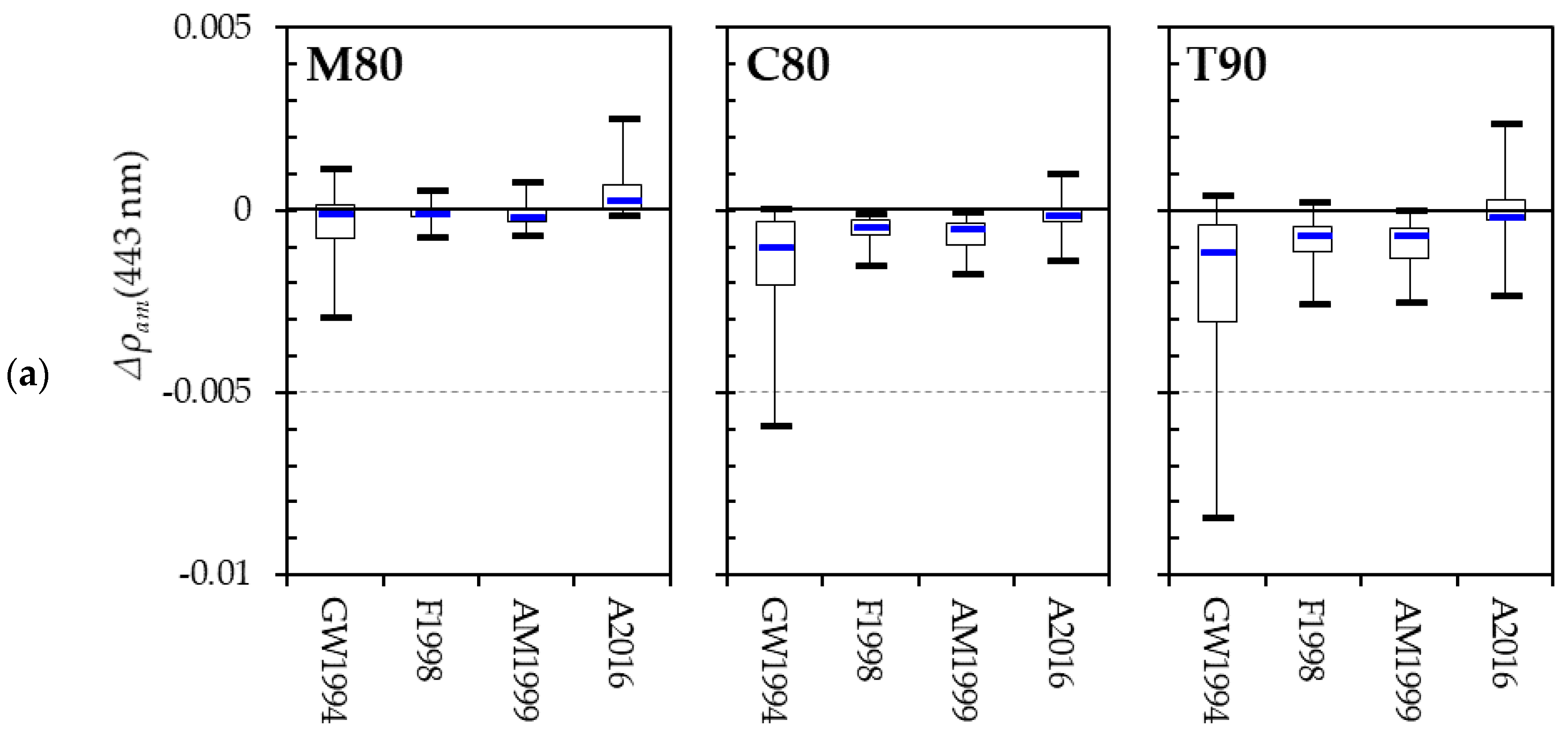
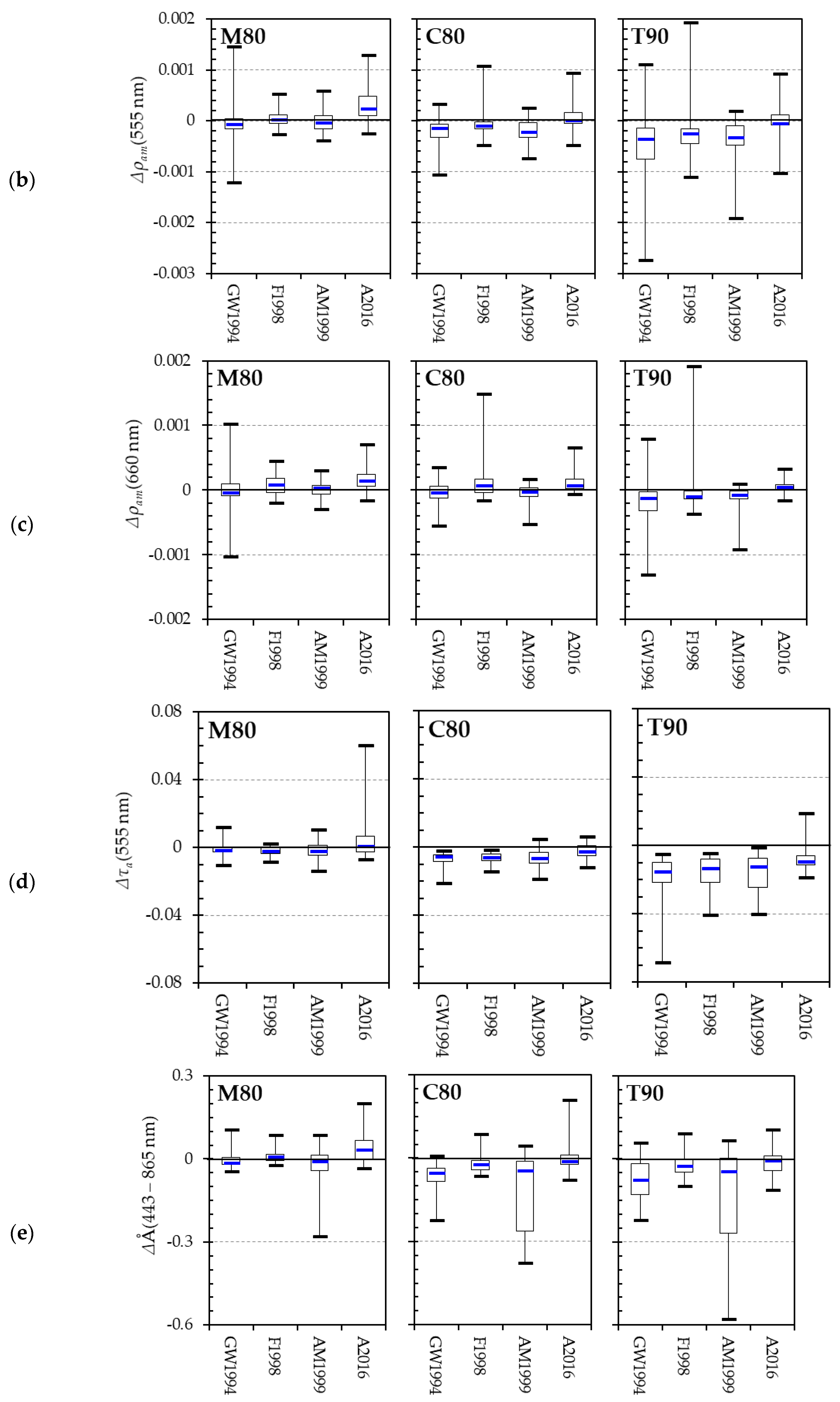
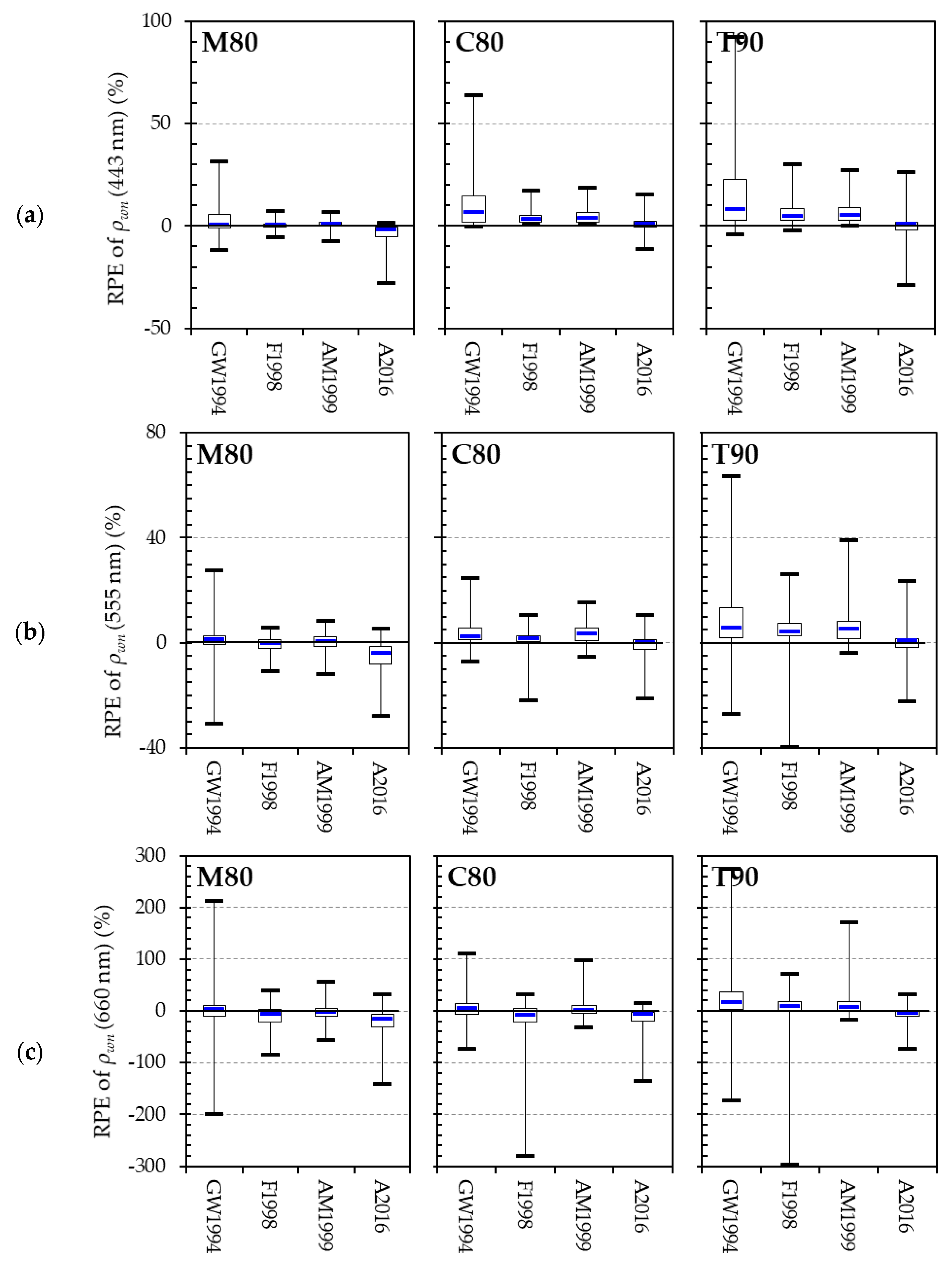
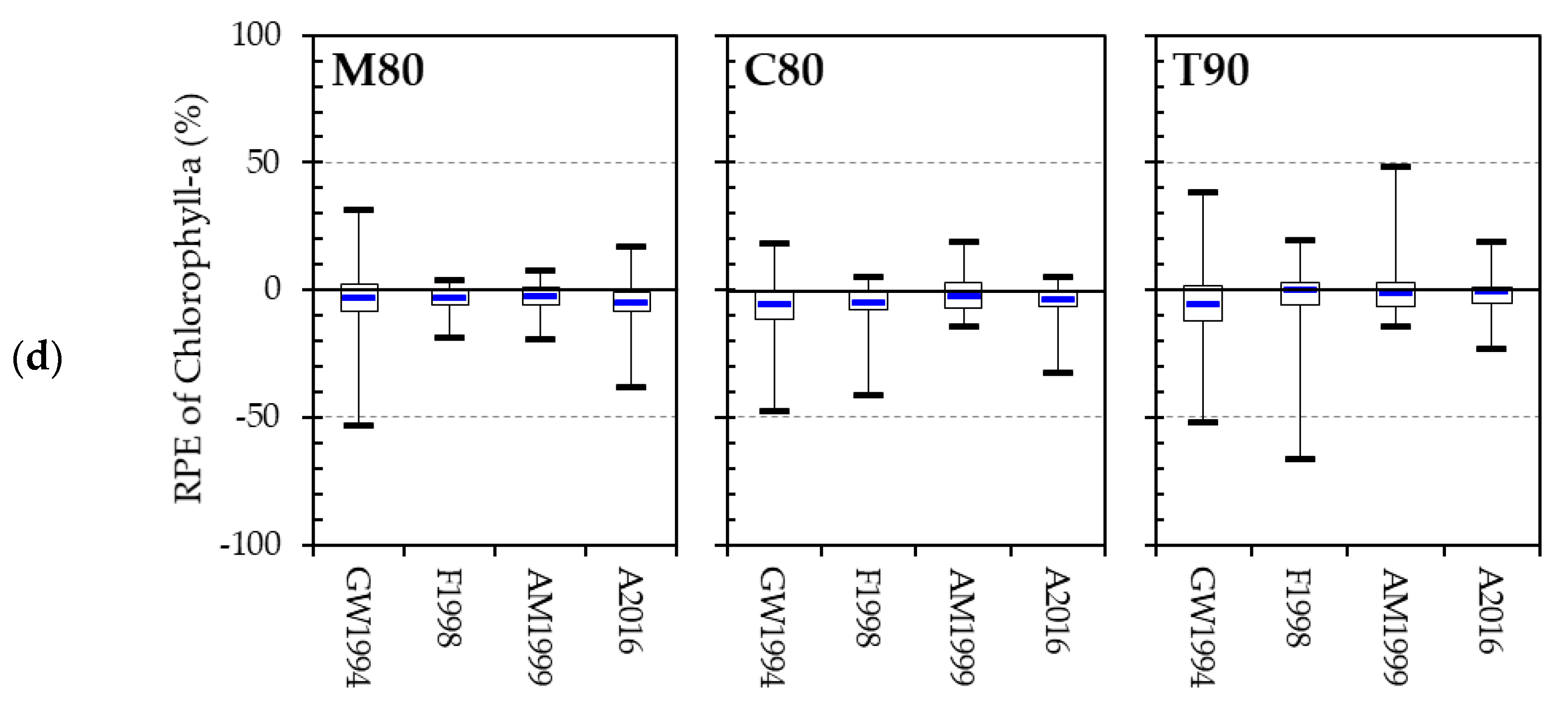
| Method | References | Applied Sensors | Aerosol Model Selection Domain |
|---|---|---|---|
| GW1994 | [9,10] | SeaWiFS, MODIS, VIIRS | Single-scattering |
| F1998 | [16,17] | OCTS, GLI, SGLI | Aerosol optical thickness |
| AM1999 | [18,19] | MERIS, OLCI | Multiple-scattering |
| A2016 | [20] | GOCI, GOCI-II | Multiple-scattering |
| λ1 (nm) | 865 | 745 | 745 | 745 | 555 | 555 | 555 |
| λ2 (nm) | 745 | 680 | 660 | 555 | 490 | 443 | 412 |
| D | 2 | 3 | 3 | 4 | 4 | 4 | 4 |
| Min. R2 | 0.99978 | 0.99995 | 0.99996 | 0.99999 | 0.99994 | 0.99996 | 0.99998 |
| Input Parameter | Values |
|---|---|
| Wavelengths | 412, 443, 490, 555, 660, 680, 745, 865 (nm) |
| Aerosol models | M80, C80, T90 |
| Aerosol optical thicknesses at 865 nm | 0.03, 0.07, 0.15, 0.25, 0.35 |
| Wind speed at sea surface | 2 m/s |
| Solar-zenith angles (θs) | 0°, 25°, 50°, 75° |
| Viewing zenith angles (θs) | 20°, 40°, 60° |
| Relative azimuth angles (ϕsv) | 60°, 120° |
| Chlorophyll-a concentration | 0.1, 0.3, 1.0 mg/m3 |
| ρwn(443 nm) | ρwn(555 nm) | ρwn(660 nm) | ||||||||
|---|---|---|---|---|---|---|---|---|---|---|
| Method | MAPE | Med. | RMSE | MAPE | Med. | RMSE | MAPE | Med. | RMSE | |
| Total | GW1994 | 10.0% | 5.1% | 0.00198 | 6.7% | 3.5% | 0.00059 | 27.9% | 14.4% | 0.00032 |
| F1998 | 3.9% | 2.4% | 0.00068 | 3.5% | 2.4% | 0.00030 | 18.3% | 12.5% | 0.00023 | |
| AM1999 | 4.3% | 2.9% | 0.00077 | 4.3% | 3.3% | 0.00035 | 11.9% | 8.0% | 0.00013 | |
| A2016 | 3.4% | 1.8% | 0.00067 | 3.9% | 2.2% | 0.00034 | 15.6% | 9.2% | 0.00017 | |
| M80 | GW1994 | 4.8% | 2.4% | 0.00098 | 4.5% | 2.1% | 0.00042 | 25.4% | 10.9% | 0.00031 |
| F1998 | 1.2% | 0.9% | 0.00021 | 2.0% | 1.4% | 0.00016 | 16.5% | 11.5% | 0.00016 | |
| AM1999 | 1.8% | 1.4% | 0.00031 | 2.6% | 2.0% | 0.00021 | 11.2% | 7.6% | 0.00012 | |
| A2016 | 4.1% | 2.0% | 0.00085 | 5.8% | 4.0% | 0.00045 | 22.0% | 15.4% | 0.00022 | |
| C80 | GW1994 | 10.4% | 6.4% | 0.00187 | 4.5% | 2.6% | 0.00037 | 18.0% | 11.5% | 0.00019 |
| F1998 | 4.1% | 3.2% | 0.00062 | 2.5% | 1.9% | 0.00020 | 18.2% | 11.7% | 0.00023 | |
| AM1999 | 4.9% | 3.6% | 0.00078 | 4.1% | 3.6% | 0.00029 | 10.5% | 7.9% | 0.00011 | |
| A2016 | 2.7% | 1.8% | 0.00046 | 2.8% | 1.6% | 0.00024 | 14.5% | 8.9% | 0.00016 | |
| T90 | GW1994 | 15.1% | 8.2% | 0.00275 | 11.1% | 7.4% | 0.00086 | 40.4% | 22.3% | 0.00042 |
| F1998 | 6.5% | 4.8% | 0.00099 | 6.1% | 4.4% | 0.00046 | 20.4% | 13.8% | 0.00028 | |
| AM1999 | 6.5% | 5.3% | 0.00104 | 6.3% | 5.0% | 0.00048 | 14.1% | 8.7% | 0.00017 | |
| A2016 | 3.4% | 1.8% | 0.00063 | 3.1% | 1.6% | 0.00027 | 9.9% | 5.7% | 0.00011 | |
 40.0%, Color scale for mean absolute percentage error (MAPE).
40.0%, Color scale for mean absolute percentage error (MAPE).© 2018 by the authors. Licensee MDPI, Basel, Switzerland. This article is an open access article distributed under the terms and conditions of the Creative Commons Attribution (CC BY) license (http://creativecommons.org/licenses/by/4.0/).
Share and Cite
Ahn, J.-H.; Park, Y.-J.; Fukushima, H. Comparison of Aerosol Reflectance Correction Schemes Using Two Near-Infrared Wavelengths for Ocean Color Data Processing. Remote Sens. 2018, 10, 1791. https://doi.org/10.3390/rs10111791
Ahn J-H, Park Y-J, Fukushima H. Comparison of Aerosol Reflectance Correction Schemes Using Two Near-Infrared Wavelengths for Ocean Color Data Processing. Remote Sensing. 2018; 10(11):1791. https://doi.org/10.3390/rs10111791
Chicago/Turabian StyleAhn, Jae-Hyun, Young-Je Park, and Hajime Fukushima. 2018. "Comparison of Aerosol Reflectance Correction Schemes Using Two Near-Infrared Wavelengths for Ocean Color Data Processing" Remote Sensing 10, no. 11: 1791. https://doi.org/10.3390/rs10111791
APA StyleAhn, J.-H., Park, Y.-J., & Fukushima, H. (2018). Comparison of Aerosol Reflectance Correction Schemes Using Two Near-Infrared Wavelengths for Ocean Color Data Processing. Remote Sensing, 10(11), 1791. https://doi.org/10.3390/rs10111791






